Fudge is one of our all-time favorite treats. It’s sweet, simple and makes a perfect gift, especially around the holidays. You can typically find fudge at local candy shops, but it’s also easy to make at home.
We’ll walk you through everything—yes, everything!—you need to know about making fudge. We’ll cover the ingredients, top tips and even troubleshoot some common mistakes if you run into any issues. Ready to get started?
Psst: Take a look at our best fudge recipes.
What is fudge?
At its simplest, fudge is a dense, soft candy. Traditional fudge is flavored with chocolate, but you can utilize pretty much any flavor—like peanut butter, pumpkin or even birthday cake. And if you’re watching your sugar intake, try our Sugar-Free Chocolate Fudge.
What ingredients are in fudge?
Fudge requires three essential ingredients—sugar, butter and milk—but most recipes also include chocolate or some kind of flavoring. It’s also common to include mix-ins and toppings, like nuts, cookie pieces, marshmallows and hard candies.
What are the methods for making fudge?
The two most popular ways to make fudge are on the stove and in the microwave. For the stovetop variety, like the recipe below, you’ll heat your ingredients, cool slightly, beat with a spoon until the mixture thickens, then refrigerate until firm. For this microwave fudge recipe, you’ll zap the ingredients until they’re melted, stirring occasionally, then refrigerate until firm.
The Best Tools for Making Fudge
Luckily, fudge doesn’t require a lot of fancy tools or gadgets. In fact, you likely already have everything on hand! And no sweat if you don’t have a specific candy thermometer. A clean meat thermometer works just as well.
How to Make Fudge, Step-by-Step
This recipe for Perfect Chocolate Fudge comes to us from Dorothy Anderson of Ottawa, Kansas. “This rich chocolate fudge is sure to delight someone you love,” she says.
Ingredients
- 1-1/2 teaspoons plus 1/4 cup butter, divided
- 3 cups sugar
- 2/3 cup baking cocoa
- 1/8 teaspoon salt
- 1-1/2 cups whole milk
- 1 teaspoon vanilla extract
Yield: 64 pieces
Directions
Step 1: Prepare your pan
Start by lining an 8-inch square pan with foil. Then, grease the foil with 1-1/2 teaspoons of butter. This will help your fudge release easily from the pan when it’s finished.
Step 2: Boil the ingredients
Next, in a heavy saucepan, combine the sugar, cocoa and salt. Stir in the milk until smooth, then bring to a rapid boil over medium heat, stirring constantly.
Step 3: Cook to soft-ball stage
Once the mixture boils, insert a candy thermometer into the pan and cook, without stirring, until the thermometer reads 234°F, or soft-ball stage. Learn more about how to make candy.
Step 4: Add remaining ingredients and cool
Remove the mixture from the heat and add your vanilla and remaining butter. Be careful that you do not stir, though. That step comes later!
Step 5: Beat until thick
Let the mixture cool to 110°F. Then, beat with a spoon until the fudge thickens and just begins to lose its gloss. Immediately spread the mixture into your prepared pan and let cool completely.
Step 6: Set and serve
Ahh, finally—it’s time to dig in! Using the foil liner, gently lift the fudge out of the pan. Peel the foil away and discard, then cut the fudge into 1-inch squares. Serve and enjoy!
Psst! These fudge recipes taste like vacation.
What are the best toppings for fudge?
When it comes to fudge toppings, your sweet tooth is the limit! Feel free to add:
- Crushed candies
- Chopped nuts
- Sprinkles
- Glazed bacon
- Dried fruit
- Peanut butter or Nutella swirl
- Cookie crumbs
- Cereal
How long does fudge last?
It depends. Most fudge will last for one to two weeks when stored in an airtight container at room temperature. You can also prolong the life of your fudge by storing it in the fridge or freezer. Fudge that has gone past its prime is typically rock hard or soft and gooey. Pay attention to your add-ins, too. Nuts have a tendency to spoil, and pieces of cookie can get stale. Here’s more on how long fudge lasts.
How do you thicken fudge?
If your fudge won’t set, there are a couple of things that could have gone wrong. It’s possible that the mixture wasn’t cooked to the right temperature or beaten long enough. To fix it, you can try to thicken the mixture with powdered sugar or mix-ins. Or, return the fudge to the stove, add about 1-1/2 cups of water and reheat until the mixture is once again at the soft-ball stage. Beat and set the fudge again, according to the recipe instructions.
Is there a way to soften fudge?
If your fudge is on the harder side, you can soften it by storing it on the counter, rather than in the refrigerator. The warmer storage temperature should keep the fudge a bit softer. But keep an eye out, hard fudge is a sign that your candy might be past its prime.
What makes fudge grainy?
Sugar crystals. The best way to avoid them forming in your fudge is to resist the temptation to stir your mixture once it boils. Wait until everything cools before breaking out the spoon.
What is the soft ball test?
When making candy, there are a number of tests that can help cooks ensure that their mixture has reached the right temperature and consistency. (This is especially helpful if you’re working without a thermometer). For fudge, you’ll want to use the soft ball test. When you think your fudge mixture is at or near the 234°F mark, drop a small amount of the hot candy mixture into cold water. Once cool (and removed from the water) the ball should flatten immediately and run over your finger.
Why isn’t my fudge setting?
If your fudge doesn’t set, it likely never got hot enough. In order to set up firm, fudge needs to reach at least 234°F, as indicated by a candy thermometer. Check out these other common candy making mistakes almost everyone makes.
Can I freeze fudge to make it set?
We wouldn’t recommend freezing your fudge to get it to set. Freezing can cause the fudge to cool unevenly and too quickly, messing up the texture of the fudge. Instead, let your fudge set on the counter until it reaches room temperature and then store it in the fridge.

Bavarian Mint Fudge
My sister-in-law sent this chocolate candy to us one Christmas, and it's been a traditional holiday treat in our home ever since. With just six ingredients, it couldn't be any easier to make. Find more Christmas fudge recipes.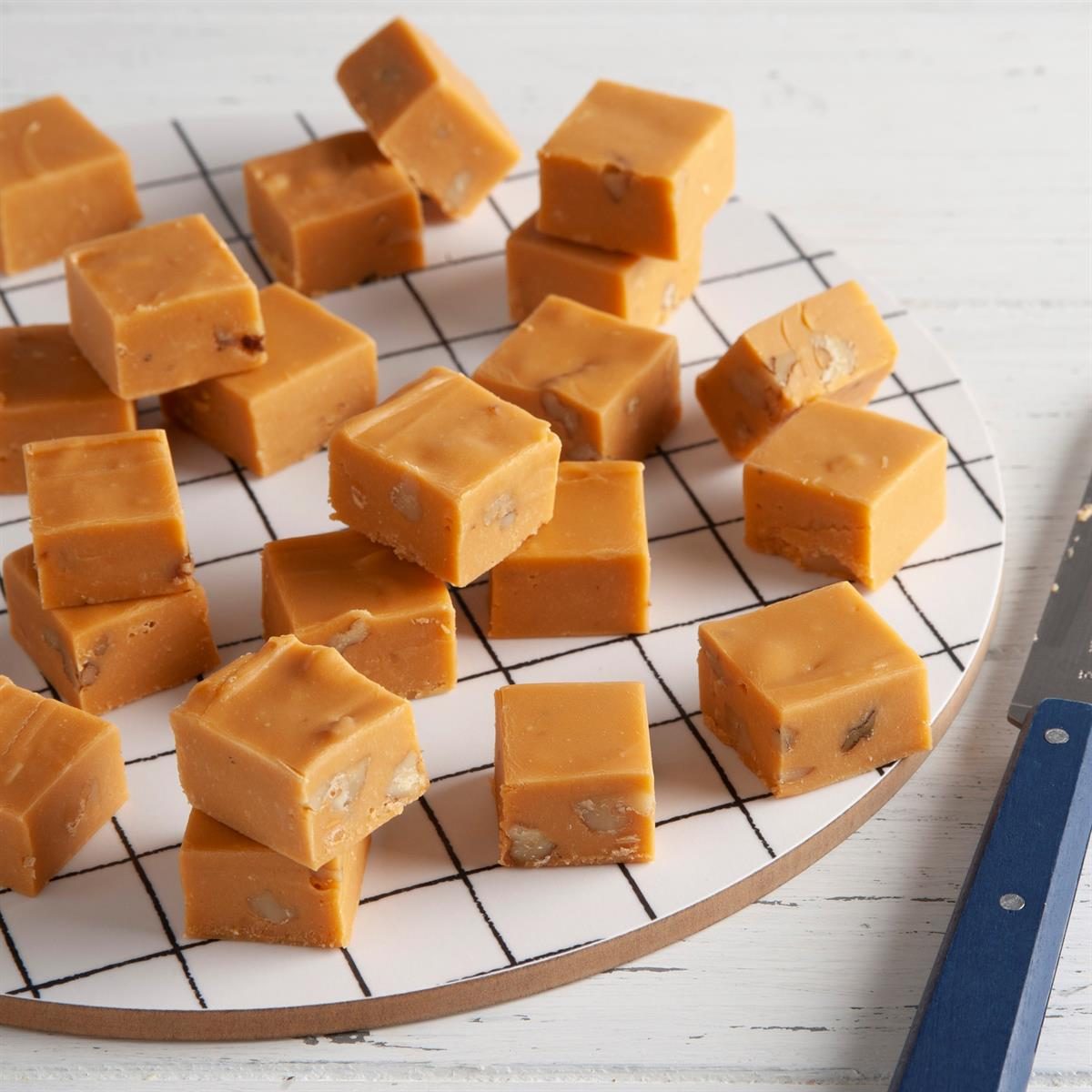
Butterscotch Fudge
Butterscotch and fudge are a match made in heaven with this award-winning recipe. Special add-ins make take this butterscotch fudge recipe to a whole new level. —Virginia Hipwell, Fenwick, Ontario
Tiger Butter Fudge
My younger brother and I share a passion for candy making. This smooth and creamy tiger butter fudge is from a co-worker of mine. —Peg Kipp, Lewisburg, Pennsylvania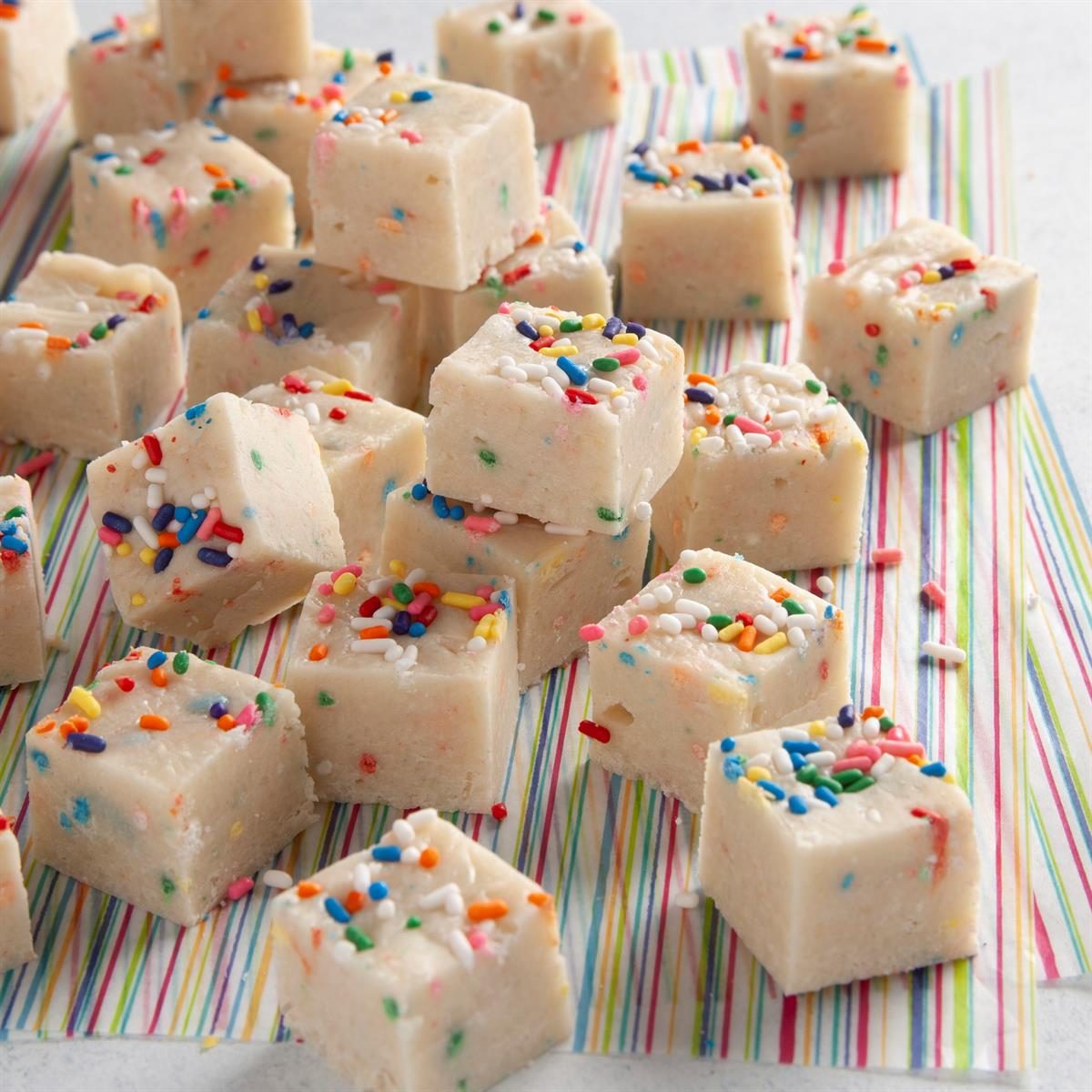
Birthday Cake Fudge
This decadent birthday cake fudge is the perfect thing to make your big day special. Or prepare it ahead and package it as a surprise gift for a friend. —Rashanda Cobbins, Milwaukee, Wisconsin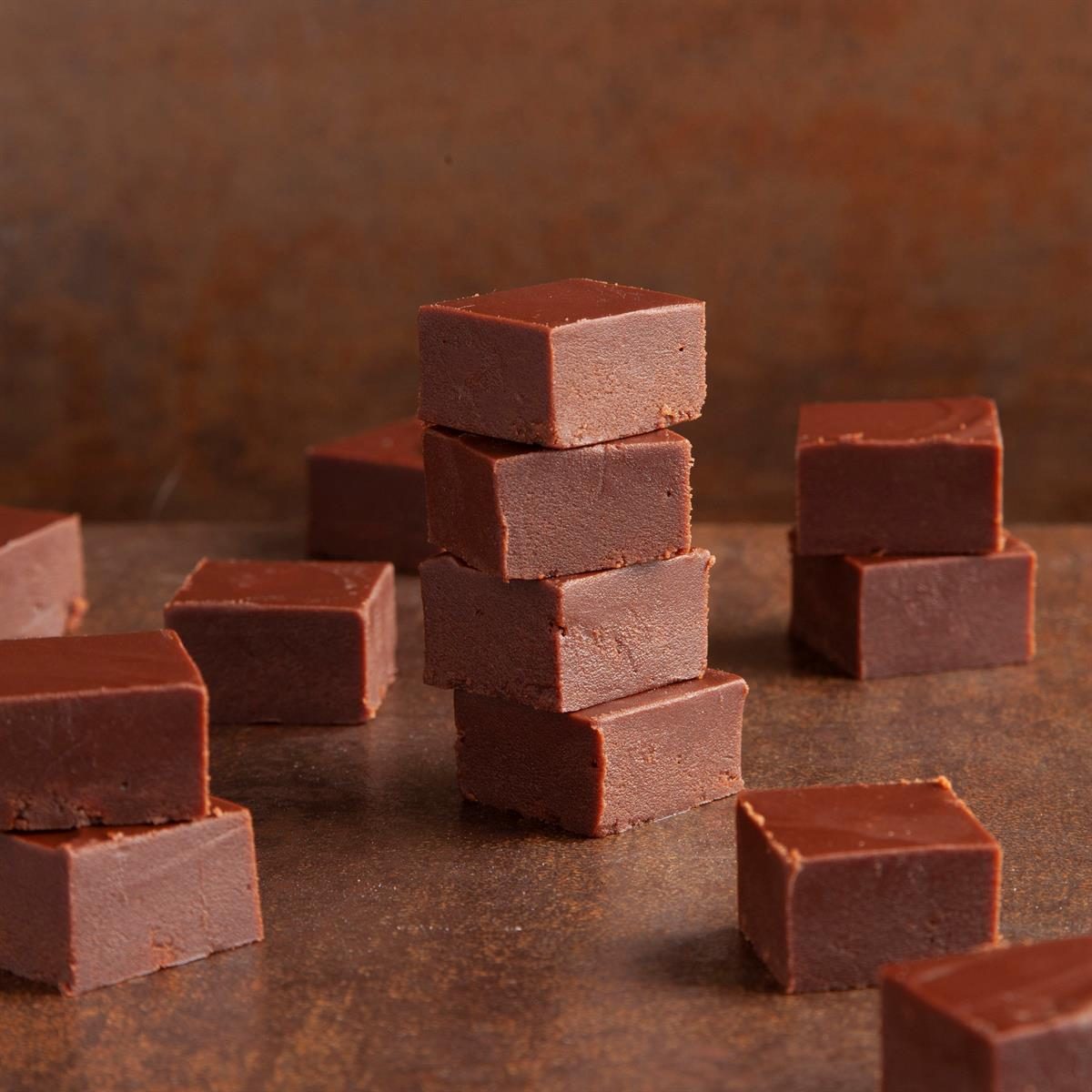
Perfect Chocolate Fudge
This rich chocolate fudge is sure to delight someone you love. And learning how to make old-fashioned fudge is easier than you think! —Dorothy Anderson, Ottawa, Kansas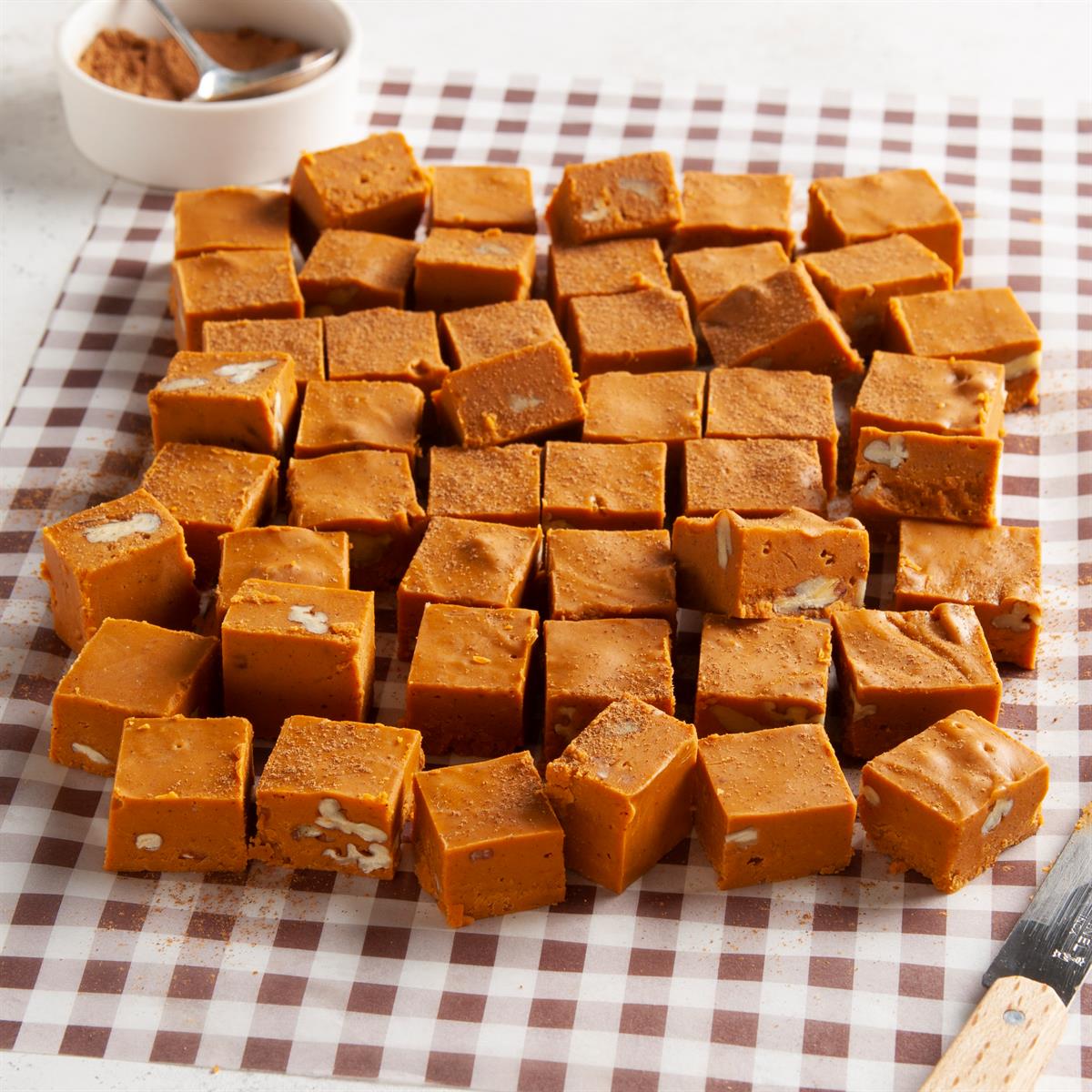
Pumpkin Fudge
I look forward to the taste of pumpkin every Thanksgiving. This easy pumpkin fudge recipe lets me do that and everyone loves it.—Marlene Fudge, Rushville, Indiana
Chocolate Cherry Fudge
This chocolate cherry fudge is unique from others, and festive for the holidays. It's a recipe my husband really enjoys. I've made it for our Homemaker group's Christmas party. By the way, these are the most popular fudge flavors. —June Lindquist, Hammond, Wisconsin
Holiday White Chocolate Fudge
When December arrives, friends and family eagerly await my creamy white fudge. It's a little something different from the traditional chocolate. —Gioviana Buser, Riverside, California
Coffee Shop Fudge
This coffee fudge recipe is one that my son, Jackson, and I worked on together. After several efforts, we decided this version was a winner. It is smooth, creamy and has an irresistible crunch from pecans. The coffee and cinnamon blend nicely to provide subtle flavor. Have you been to any of the best fudge shops in America? —Beth Osborne Skinner, Bristol, Tennessee
Creamy Peanut Butter Fudge
Christmas wouldn't be the same without this peanut butter fudge. Evaporated milk gives the treat a rich, creamy consistency, and the recipe is always a family favorite. —Diana L. Osborn, Wichita, Kansas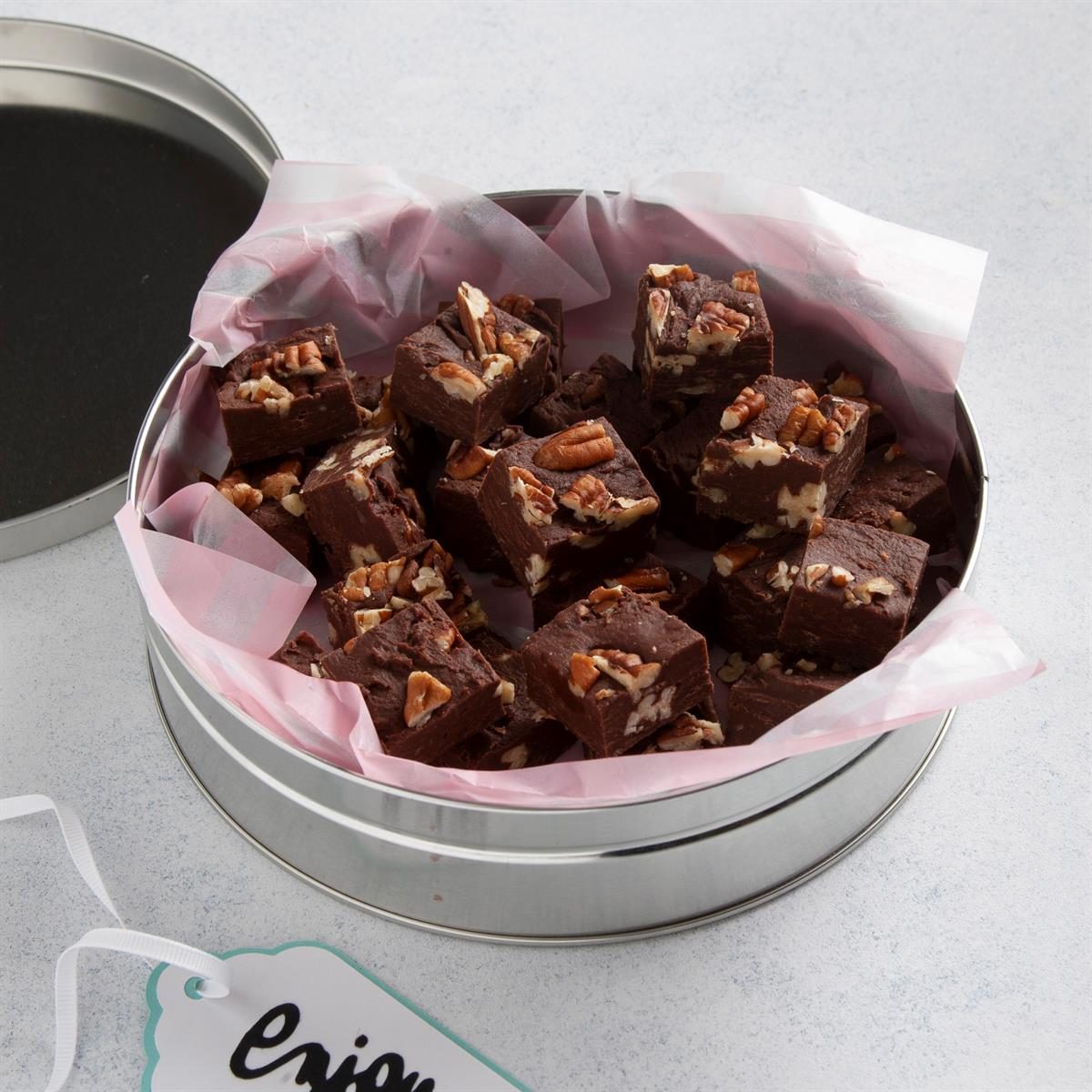
Chocolate Pecan Fudge
Even though fudge is a classic at Christmastime, people are excited for this chocolate pecan fudge year-round. Switch out the pecans with nuts that you have on hand. —Taste of Home Test Kitchen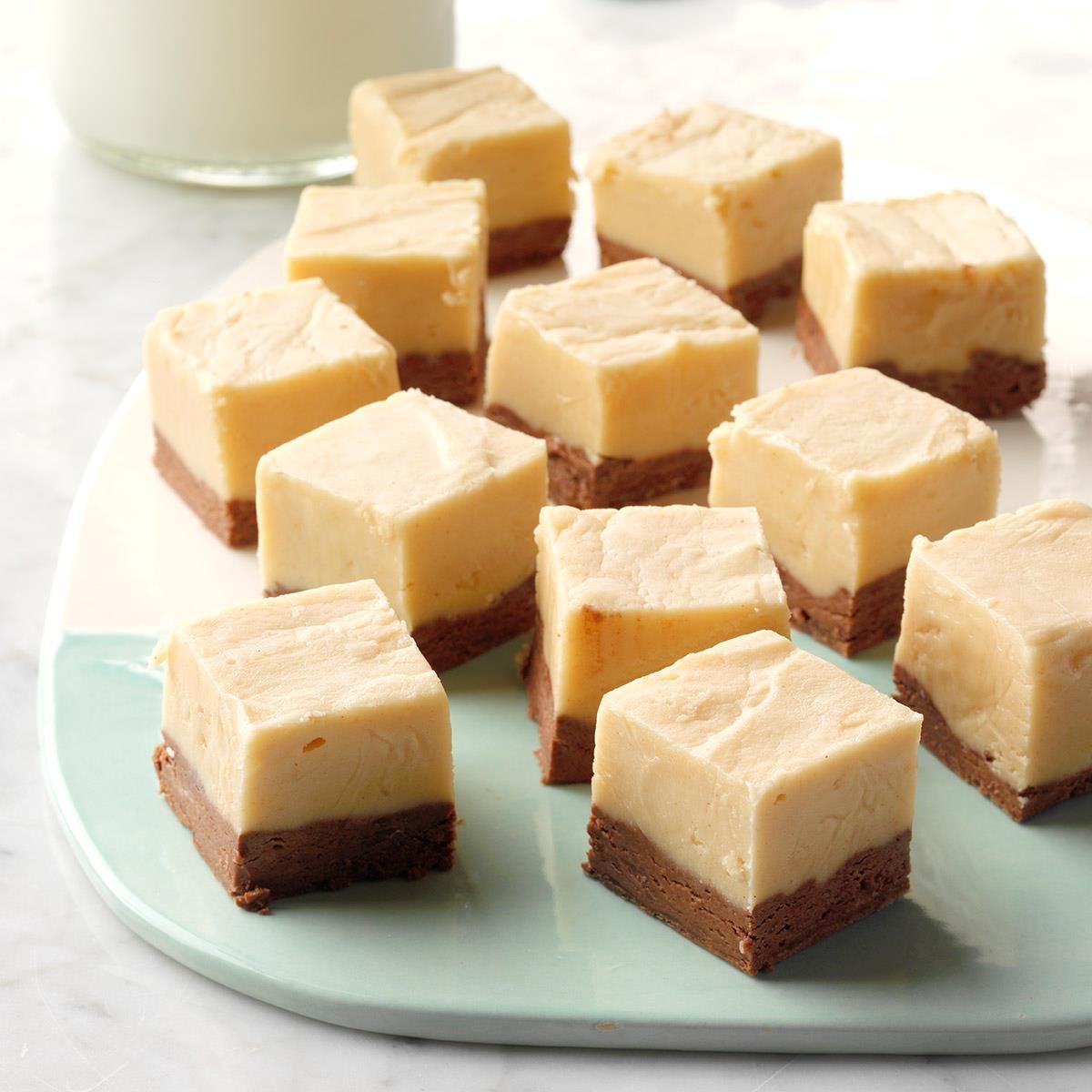
Ribbon Fantasy Fudge
I developed this recipe especially for my husband, who likes anything that has chocolate and peanut butter together! We also love these other fudgy recipes!
Mint Oreo Fudge
I altered a plain chocolate fudge recipe to create this festive mint Oreo fudge. Mint Oreo cookies can be used instead of plain for even more minty flavor. —Dawn E. Lowenstein, Huntingdon Valley, Pennsylvania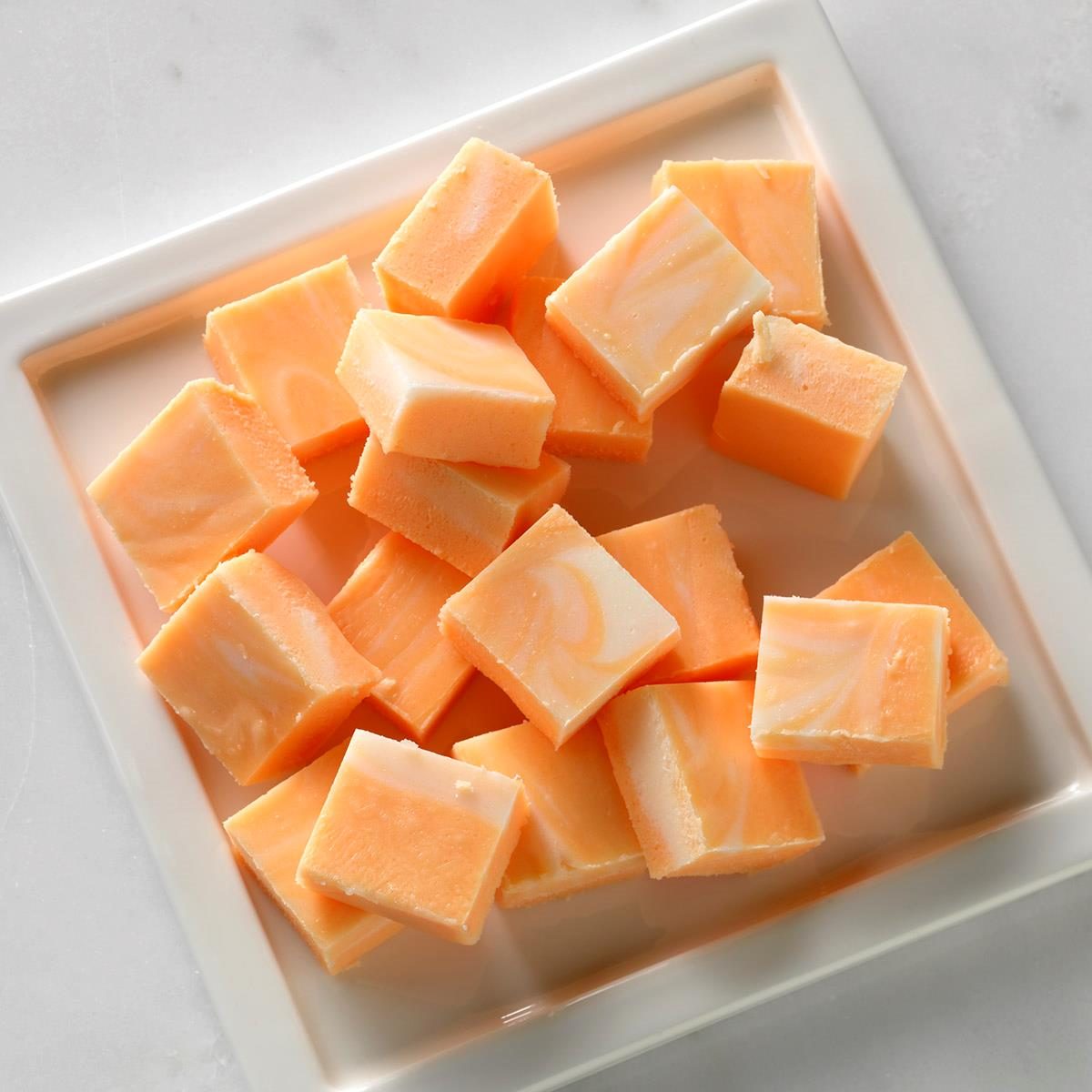
Marbled Orange Fudge
This decadent treat doesn't last long at our house. The Creamsicle flavor of this soft fudge brings on the smiles. Bright orange and marshmallow swirls make it a perfect takealong for events and get-togethers. —Diane Wampler, Morristown, Tennessee
Sugar-Free Chocolate Fudge
I'm borderline diabetic, but this sugar-free fudge made with sugar substitute appeases my sweet tooth. —Kaye Hartley, Jacksonville, FloridaBlack Cherry Swirl Fudge
This colorful treat is sure to satisfy the sweetest tooth in any family! It's always been a favorite with my nine kids, eight grandkids and my Bible study group. I even vary the soft-drink flavors to match other holidays during the year. —Pauletta Bushnell, Lebanon, Oregon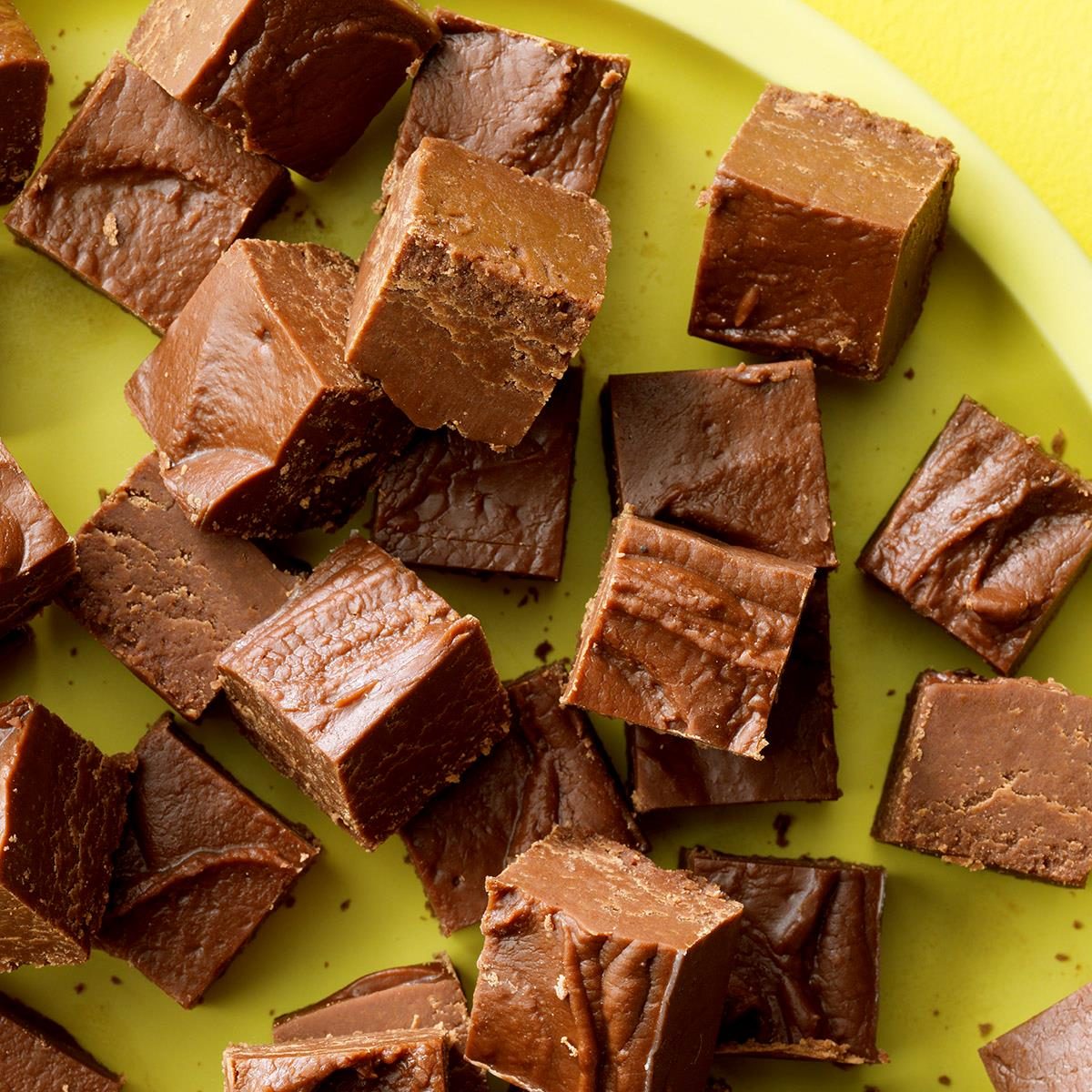
Mackinac Fudge
When I got married, a woman at my parents’ church gave me this version of a popular Michigan treat. (You'll love these gift shop fudge recipes, too). I sometimes pipe a bit of frosting onto each piece for decoration during the holidays. —Kristen Ekhoff, Akron, Indiana
Butterscotch Pumpkin Fudge
Each one of these creamy, heartwarming treats is like a bite-sized pumpkin pie. —Kathleen Henne, Camp Hill, Pennsylvania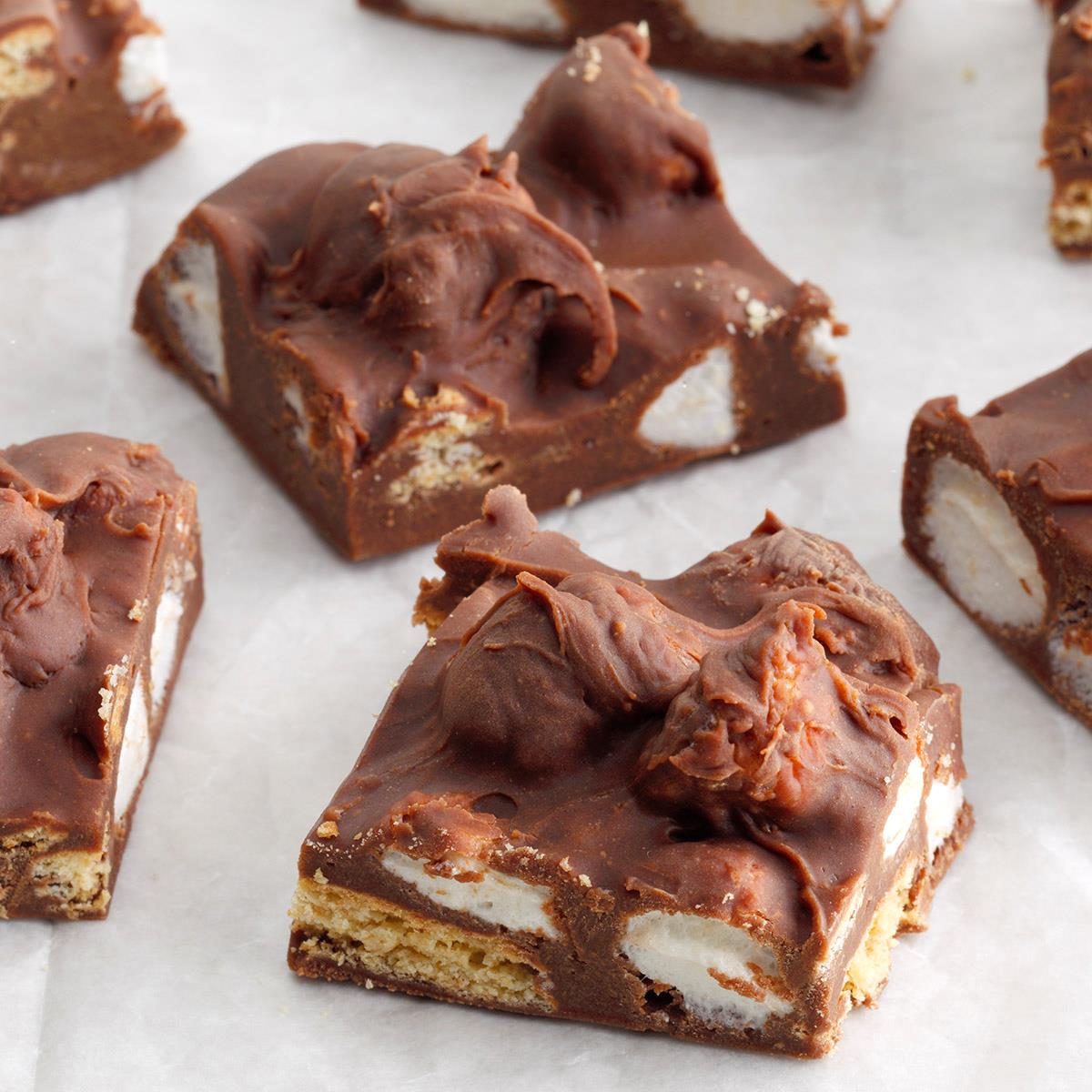
Marshmallow Fudge
You'll find it nearly impossible to resist this rich chocolate delight. It's chock-full of marshmallows and graham crackers—and no one will believe that the tantalizing treat is low in fat. —Holly Mann, Temple, New Hampshire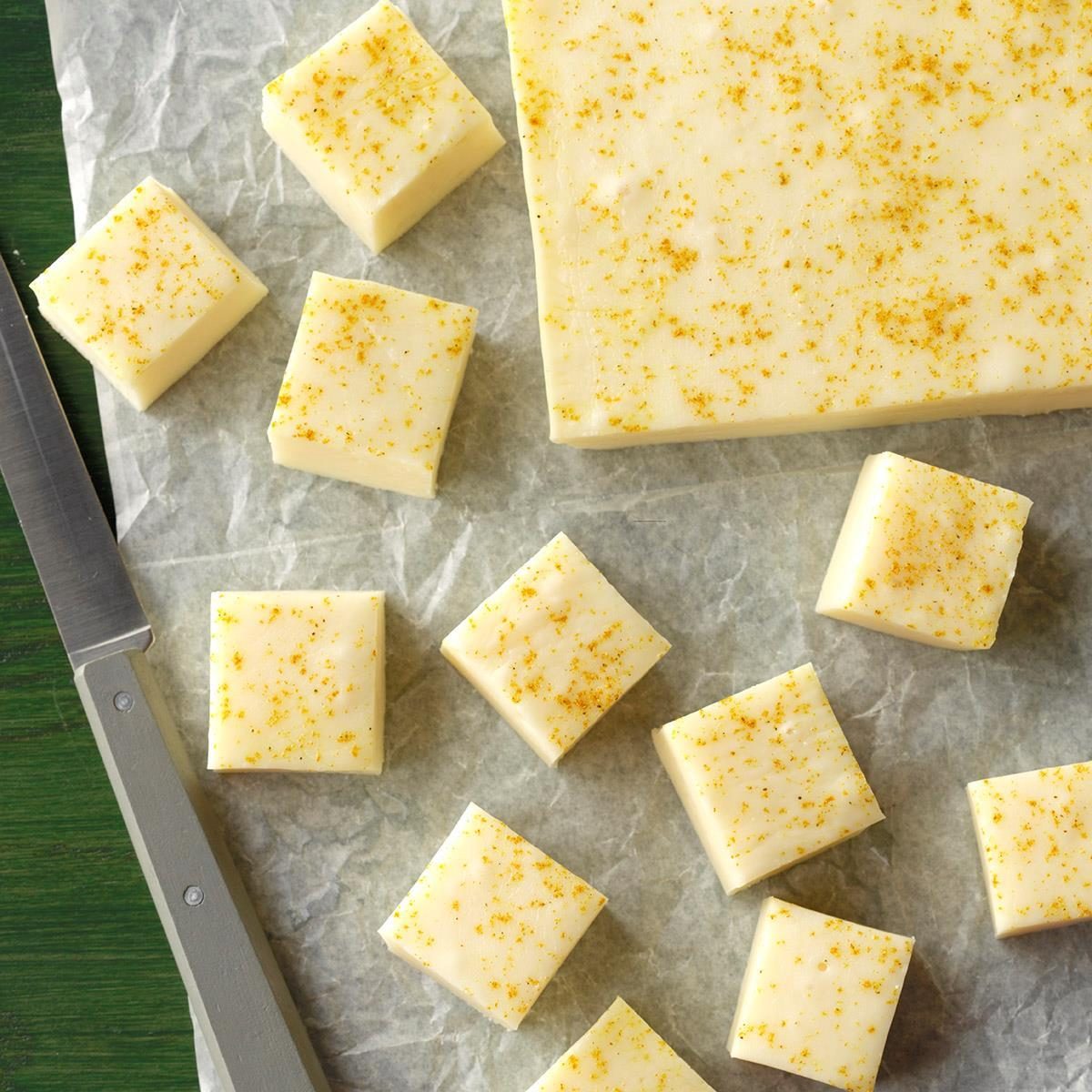
Curry-Kissed Coconut Fudge
If you love Thai flavors and love fudge, then you'll adore this creamy coconut fudge sprinkled with a hint of sweet curry powder. —Sarah Meuser, New Milford, Connecticut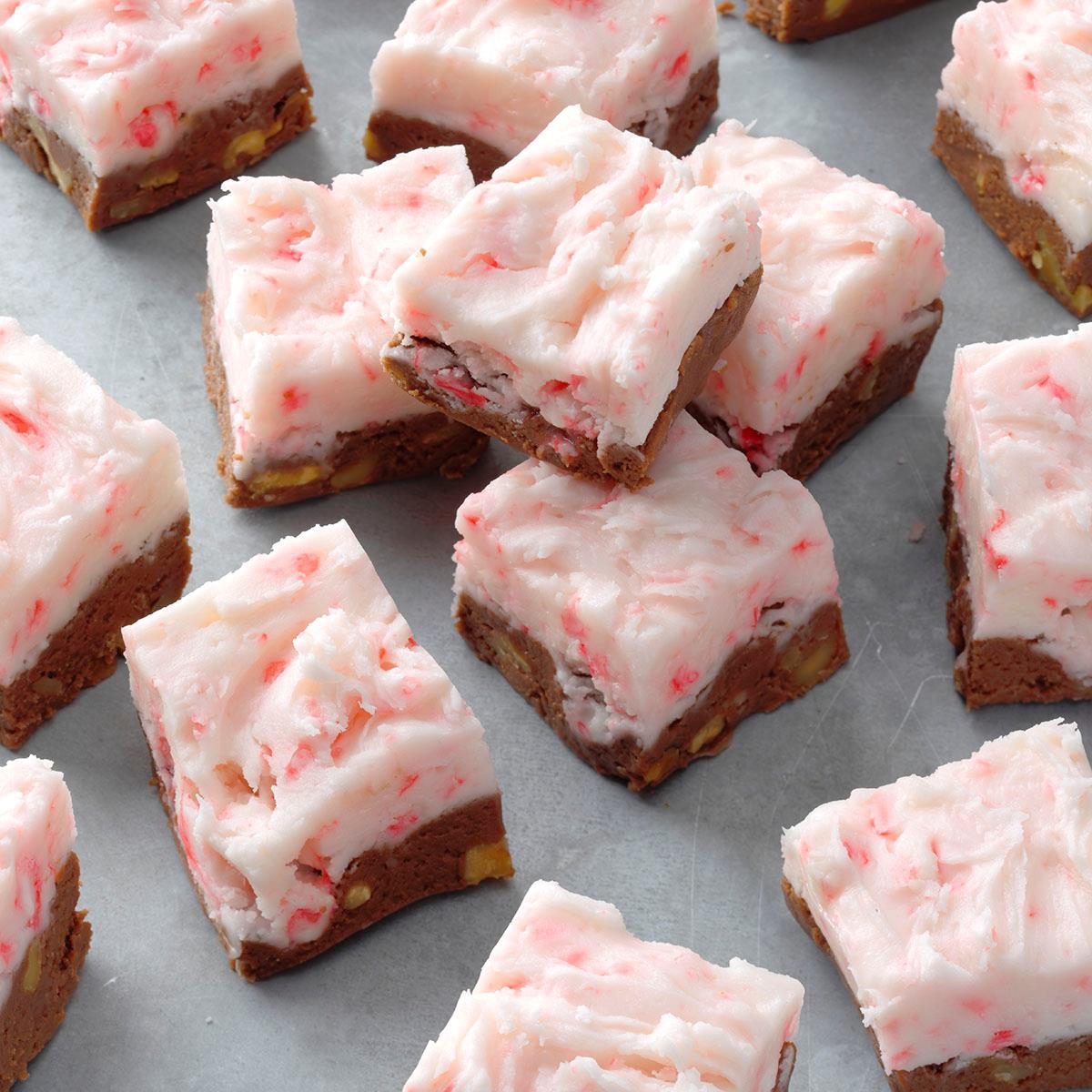
Peppermint Fudge
Three of the season's best flavors-nuts, chocolate and peppermint-combine in a delightful manner in this scrumptious fudge. The two distinct layers are eye-catching-another reason why this candy makes a great holiday gift. —Connie Denmark, St. Joseph, Illinois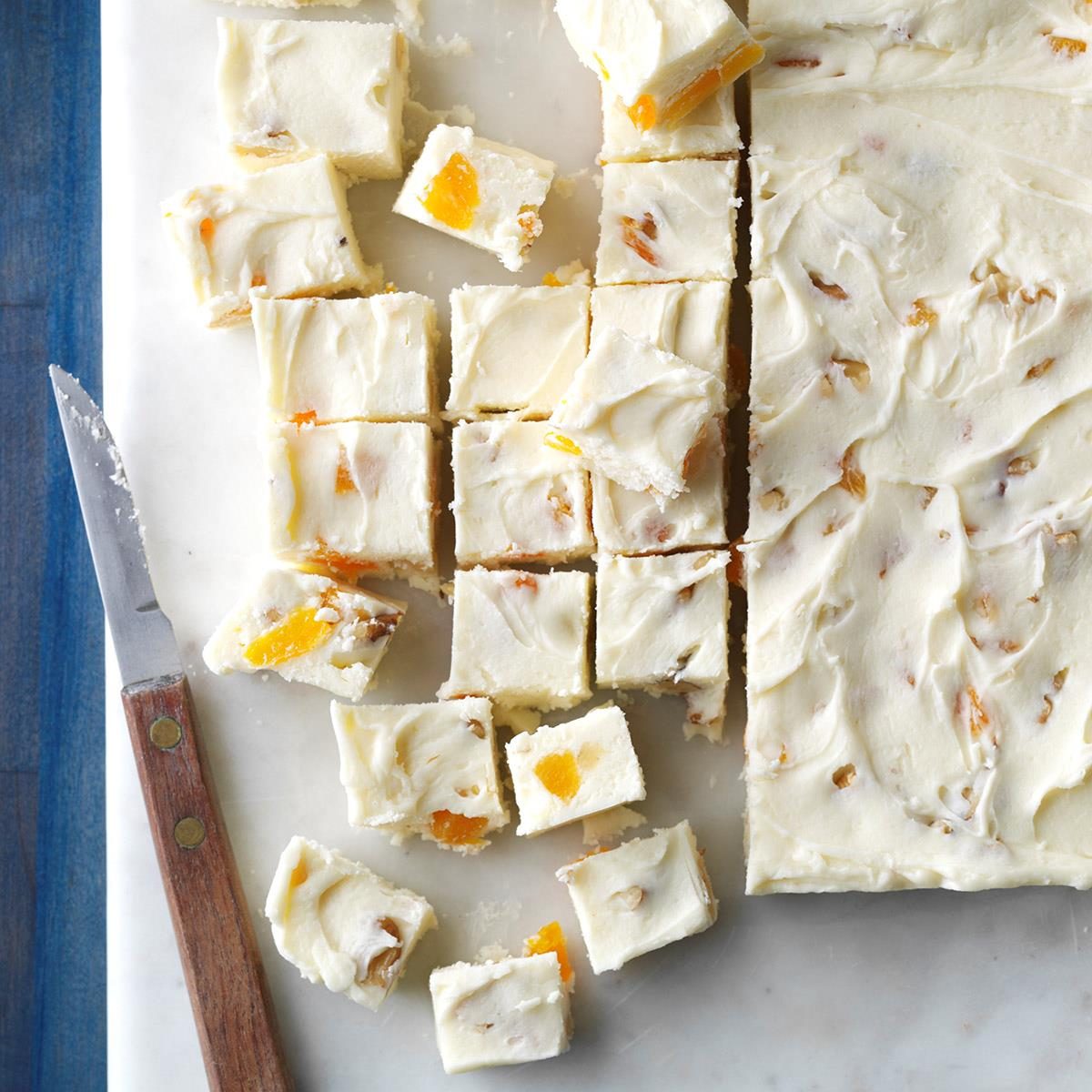
Apricot-Nut White Fudge
We look forward to this luscious apricot fudge recipe every Christmas. It's easy to make, and it melts in your mouth. I wrap up small squares of the candy with ribbon and silk holly.
Almond Cherry Fudge
Cooked in the microwave, this fast fudge is a sweet addition to any holiday gathering. I make it when I need a quick treat for a school party or to take to a neighbor. —Shellie Tucker, Hendersonvlle, Tennessee
Butter Pecan Fudge
Toasted pecans add a nutty crunch to this creamy fudge, perfect for holiday giving. People always seem to rave about its wonderful caramel flavor. —Pam Smith, Alta Loma, California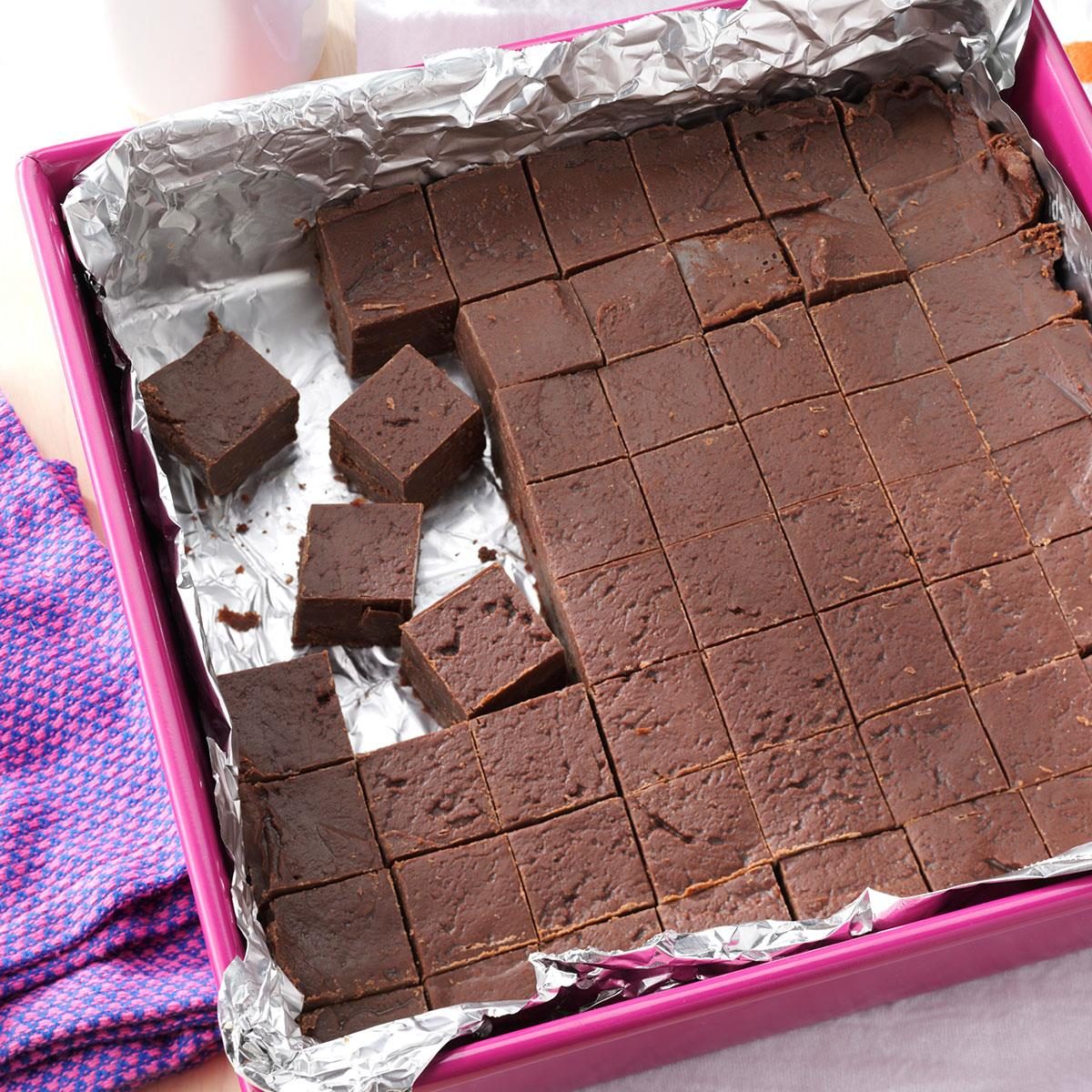
5-Ingredient Fudge
You’re moments away from a pan of creamy fudge. Just microwave, stir and spread. This easy homemade fudge recipe is the best. —Sue Tucker, Edgemoor, South Carolina
Peanut Butter Fudge
This peanut butter fudge is a favorite "never fail" quickie recipe. —Eleanore Peterson, Fort Atkinson, Wisconsin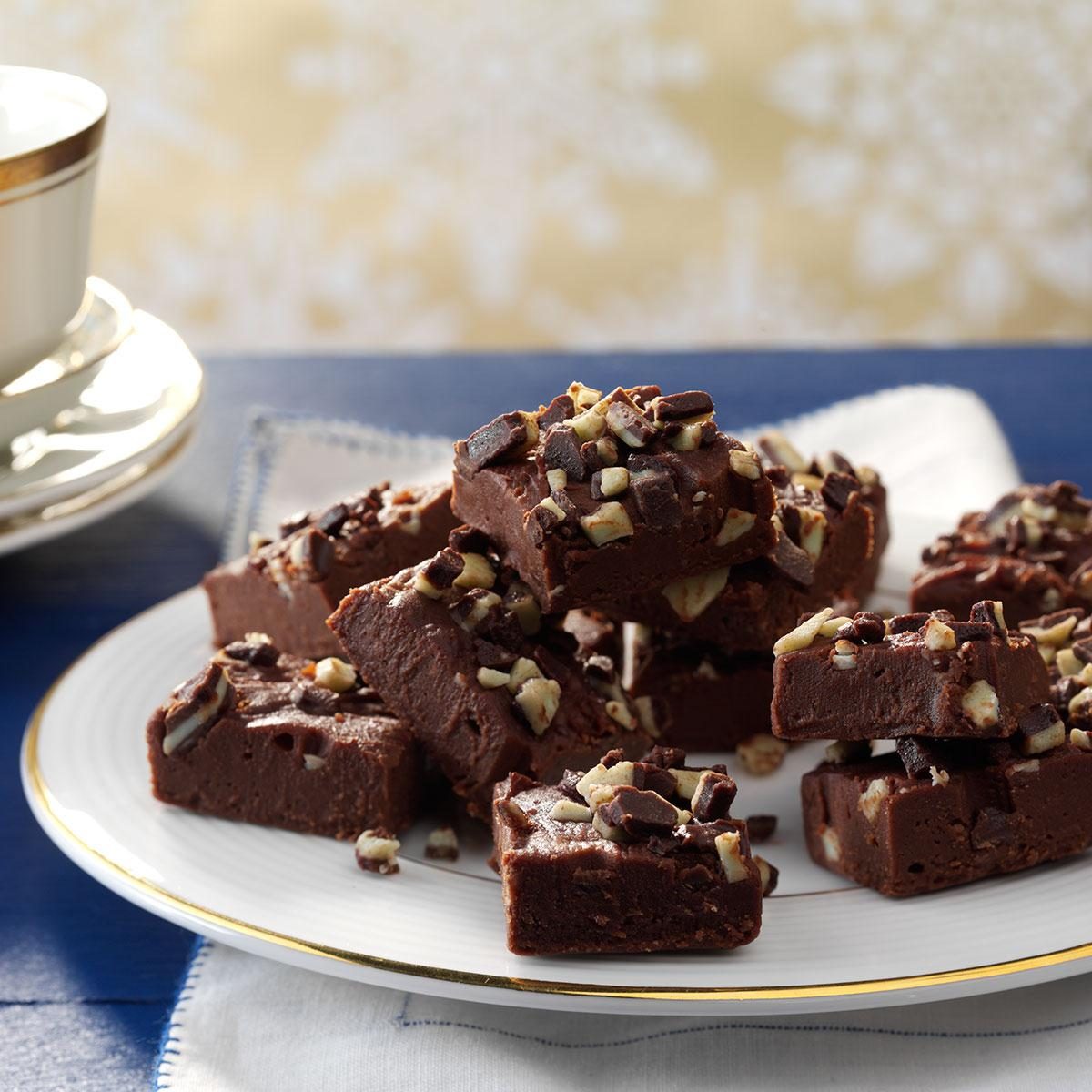
Easy Microwave Mint Fudge
I make these creamy, smooth squares not only for Christmas, but also for Valentine's Day. This easy microwave fudge is just as good as any you'd buy in a confectionery. —Donna Roberts, Manhattan, Kansas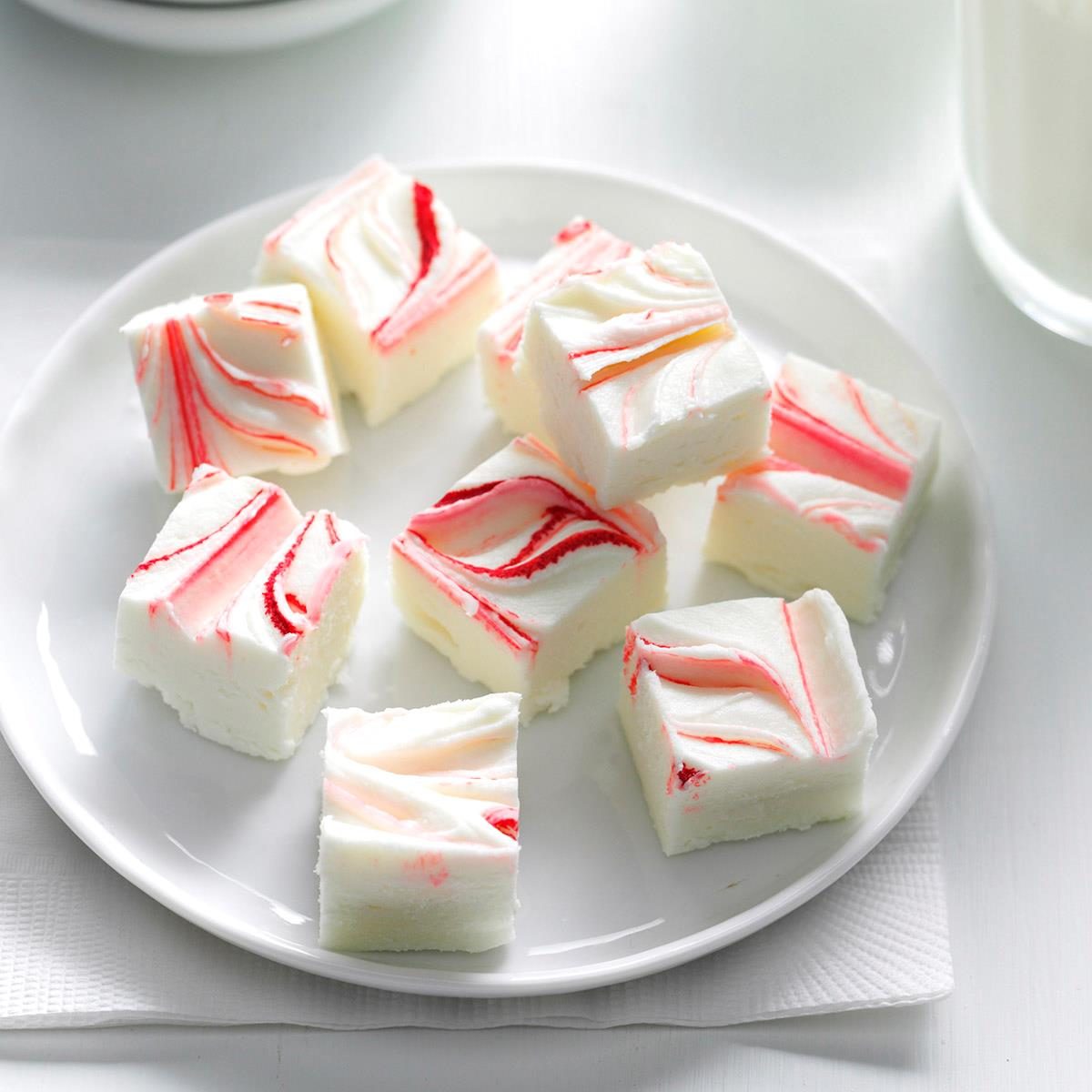
Cherry Swirl Fudge
For festive fudge with a new "twist," give this confection a whirl! We used vanilla chips instead of chocolate ones and added sweet cherry flavoring. —Taste of Home Test Kitchen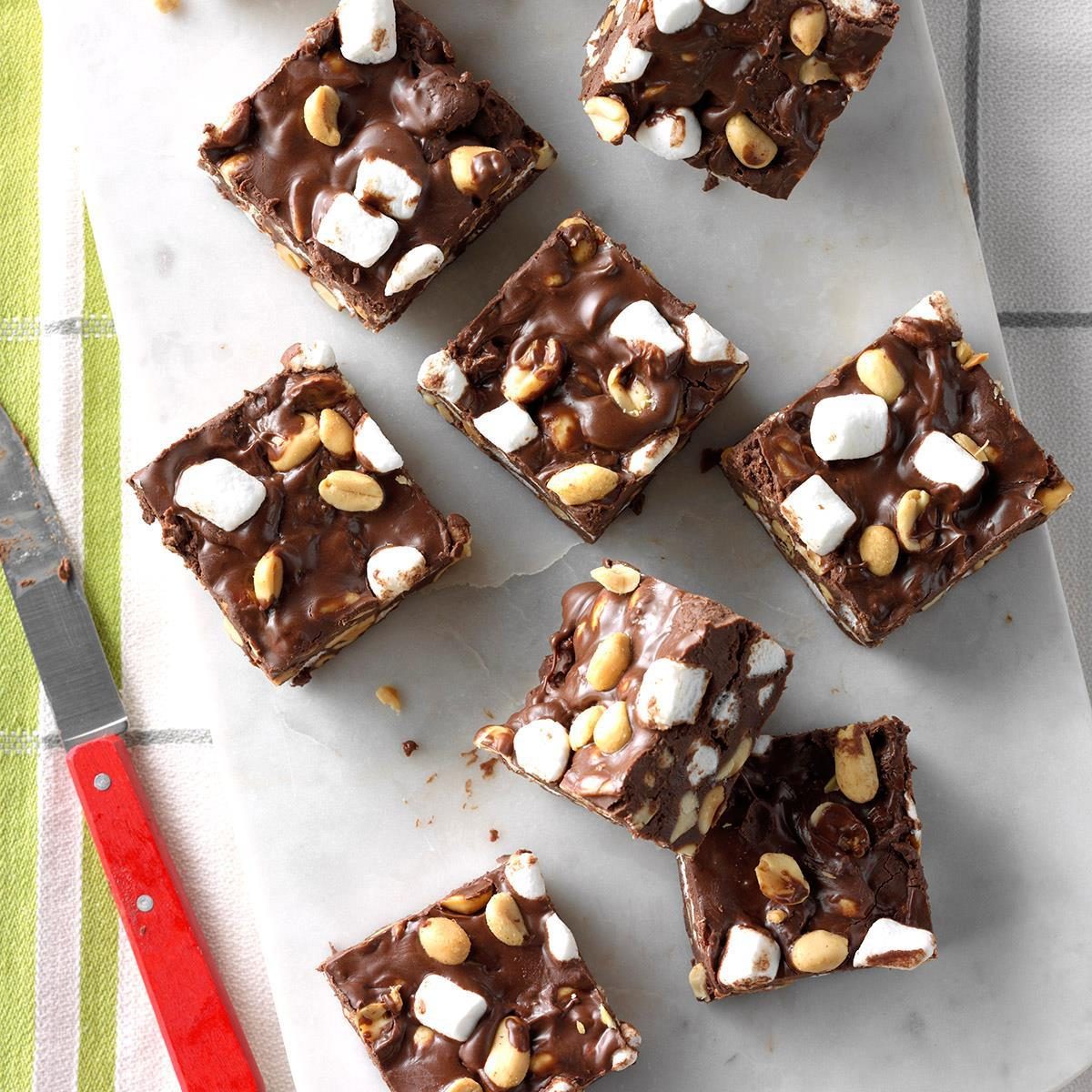
Nana's Rocky Road Fudge
We make rocky road-style fudge every Christmas and it’s a tradition, but why wait until the holidays for a recipe this good? —Ashley Berry, Montgomery Village, Maryland
Dark Chocolate Raspberry Fudge
Something about the combination of dark chocolate and raspberry is just so addicting. This fudge makes a heartfelt homemade gift, or just a treat that's worth sharing. —Barbara Lento, Houston, Pennsylvania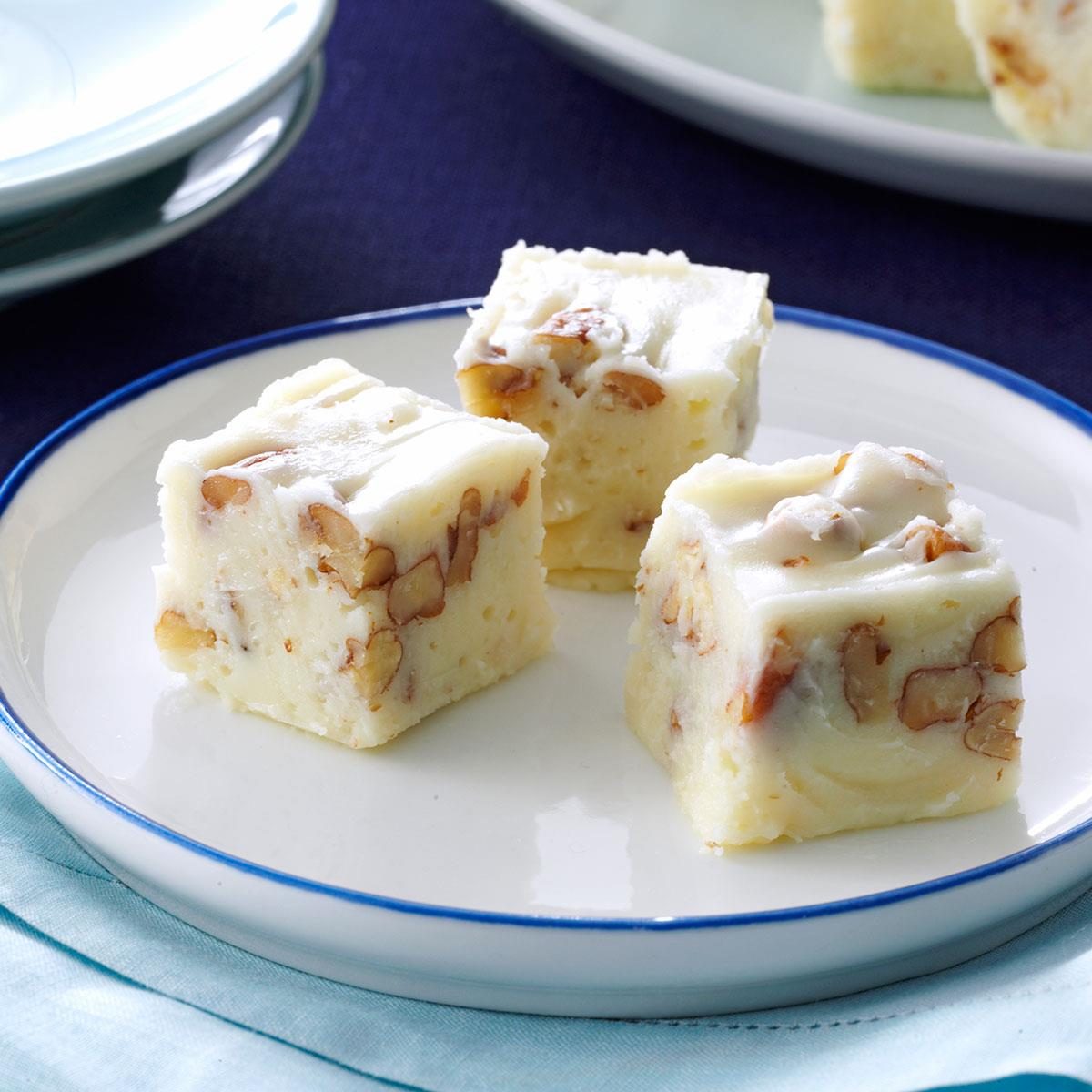
White Pecan Fudge
Each Christmas, I package batches of this rich fudge to send to family and friends. It's just delicious! —Marie Draper, Price, Utah
Candy Bar Fudge
My manager at work, who knows I like to try new treat recipes, shared this one with me. I've made this chewy and chocolaty fudge many times since. Packed with nuts and caramel, it's like a candy bar. Everyone who's tried it loves it. —Lois Freeman, Oxford, Michigan
Kahlua Fudge
This five-ingredient recipe makes serving up treats easy and scrumptious. —Laura Hanks, Harleysville, Pennsylvania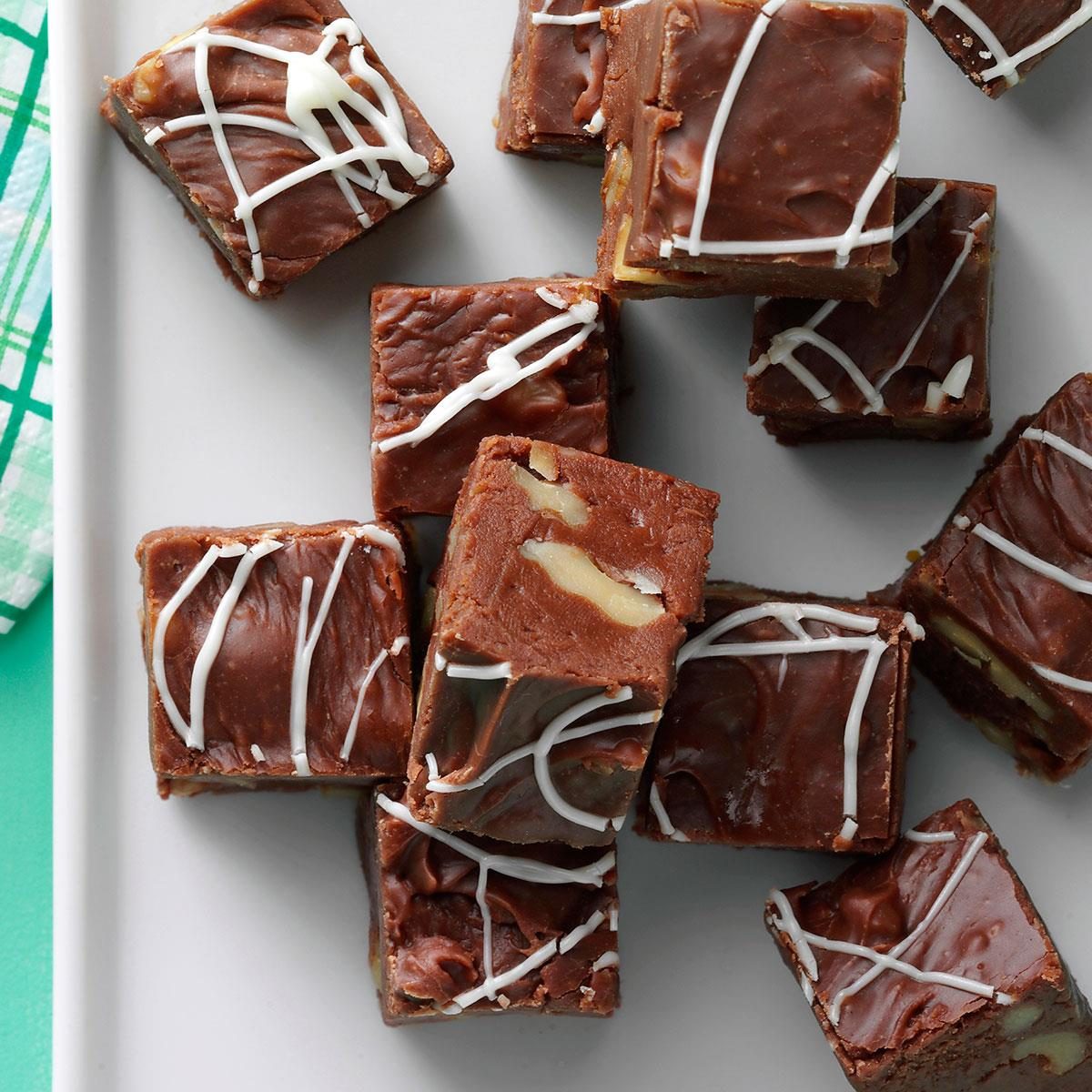
My Christmas Fudge
This fudge is virtually foolproof and so creamy you won't believe it. I've searched for years for the richest fudge, and this one does it for me. You can add just about anything you like to customize it.—Barbara Miller, Oakdale, Minnesota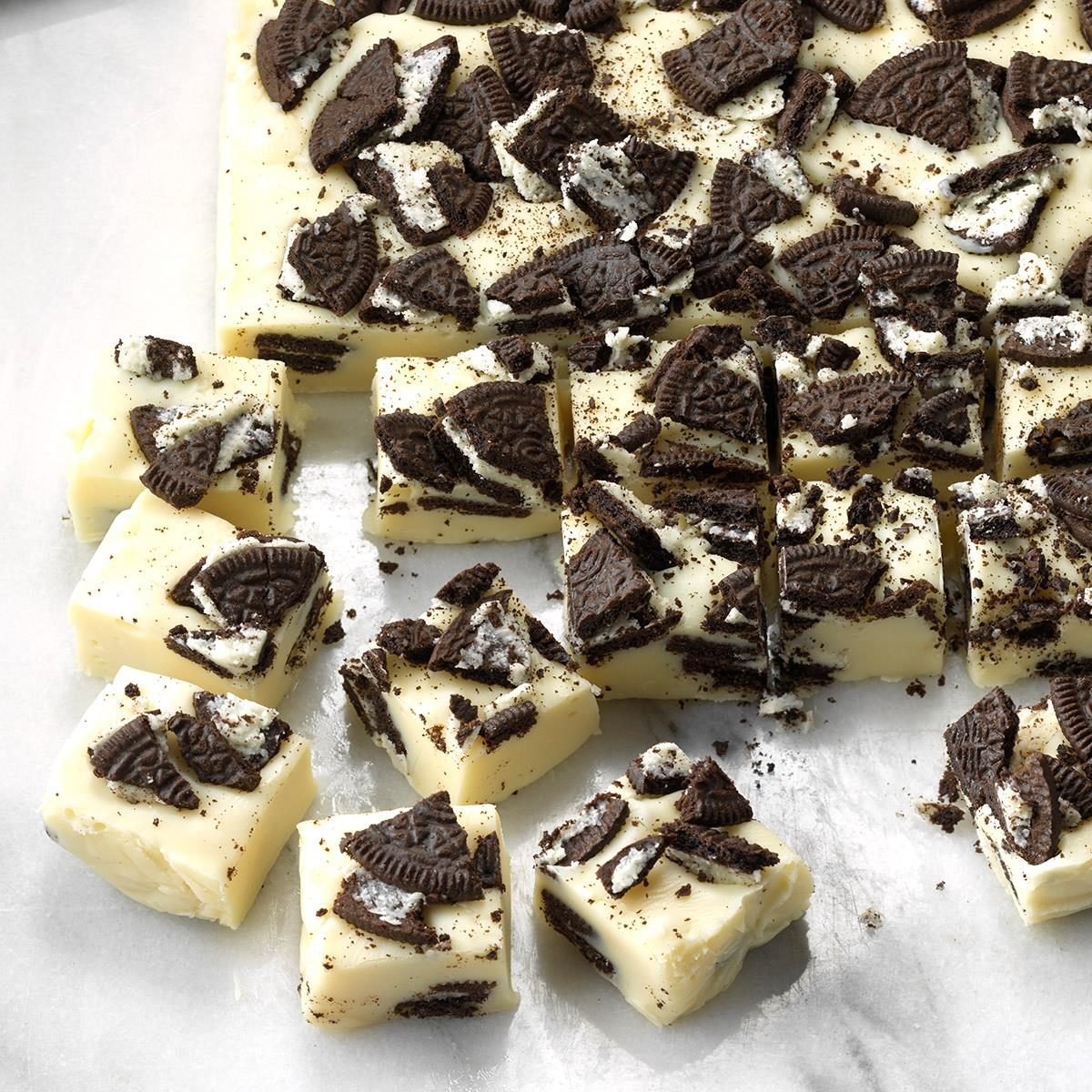
Cookies 'n' Cream Fudge
I invented this confection for a bake sale at our children's school. Boy, was it a hit! The crunchy chunks of sandwich cookie soften a bit as the mixture mellows. It's so sweet that one panful serves a crowd. —Laura Lane, Richmond, VirginiaThe post How to Make Fudge the Old-Fashioned Way appeared first on Taste of Home.
source https://www.tasteofhome.com/article/how-to-make-fudge/







0 Response to "How to Make Fudge the Old-Fashioned Way"
Post a Comment